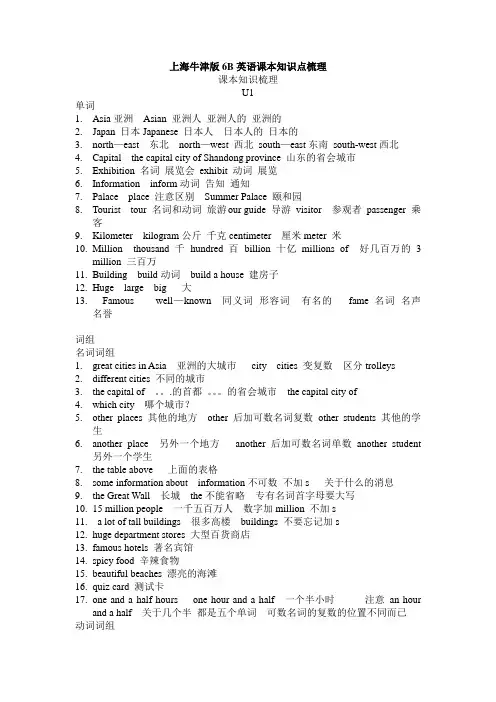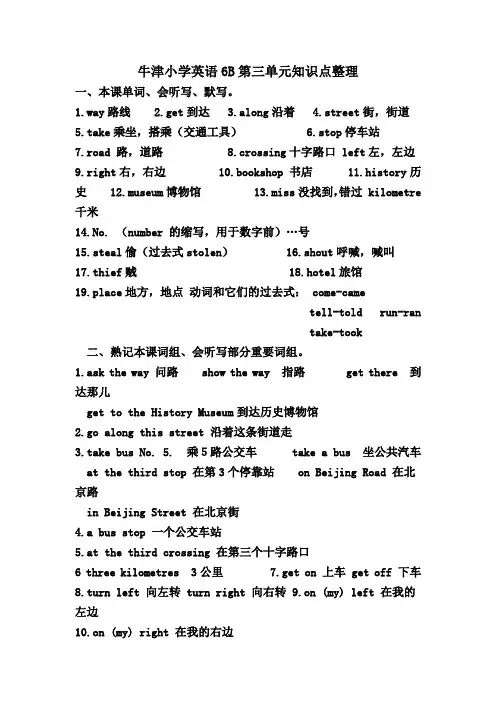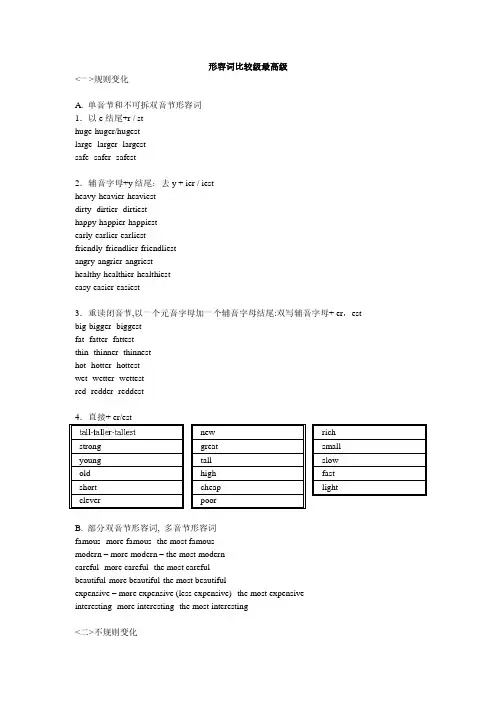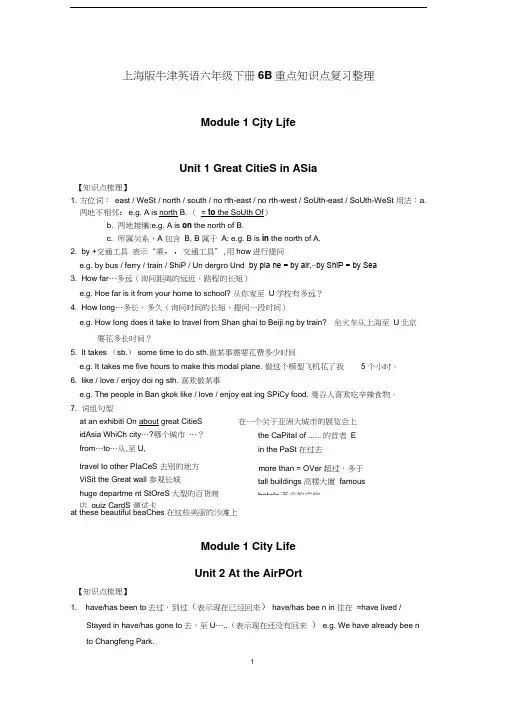上海牛津英语6B知识点梳理
沪教版英语6B单元知识梳理【范本模板】

上海牛津版6B英语课本知识点梳理课本知识梳理U1单词亚洲Asian 亚洲人亚洲人的亚洲的2.Japan 日本Japanese 日本人日本人的日本的3.north—east 东北north—west 西北south—east东南south-west西北4.Capital the capital city of Shandong province 山东的省会城市5.Exhibition 名词展览会exhibit 动词展览rmation inform动词告知通知7.Palace place 注意区别Summer Palace 颐和园8.Tourist tour 名词和动词旅游our guide 导游visitor 参观者passenger 乘客9.Kilometer kilogram公斤千克centimeter 厘米meter 米lion thousand千hundred百billion 十亿millions of 好几百万的 3million 三百万11.Building build动词build a house 建房子12.Huge large big 大13.Famous well—known 同义词形容词有名的fame 名词名声名誉词组名词词组1.great cities in Asia 亚洲的大城市city cities 变复数区分trolleys2.different cities 不同的城市3.the capital of 。
.的首都。
的省会城市the capital city of4.which city 哪个城市?5.other places 其他的地方other 后加可数名词复数other students 其他的学生6.another place 另外一个地方another 后加可数名词单数another student另外一个学生7.the table above 上面的表格8.some information about information不可数不加s 关于什么的消息9.the Great Wall 长城the不能省略专有名词首字母要大写10.15 million people 一千五百万人数字加million 不加s11. a lot of tall buildings 很多高楼buildings 不要忘记加s12.huge department stores 大型百货商店13.famous hotels 著名宾馆14.spicy food 辛辣食物15.beautiful beaches 漂亮的海滩16.quiz card 测试卡17.one and a half hours one hour and a half 一个半小时注意an hourand a half 关于几个半都是五个单词可数名词的复数的位置不同而已动词词组18.look at the map 看地图19.travel to sp go to sp 去某地20.ask and answer the questions 问答问题21.read some information about 阅读关于.。
上海牛津英语六年级第二学期6B英语知识点汇总U1-U9[2]
![上海牛津英语六年级第二学期6B英语知识点汇总U1-U9[2]](https://uimg.taocdn.com/50c711bc0b1c59eef9c7b4cf.webp)
上海牛津英语六年级第二学期6B英语知识点汇总U1-U9(word版可编辑修改)编辑整理:尊敬的读者朋友们:这里是精品文档编辑中心,本文档内容是由我和我的同事精心编辑整理后发布的,发布之前我们对文中内容进行仔细校对,但是难免会有疏漏的地方,但是任然希望(上海牛津英语六年级第二学期6B英语知识点汇总U1-U9(word版可编辑修改))的内容能够给您的工作和学习带来便利。
同时也真诚的希望收到您的建议和反馈,这将是我们进步的源泉,前进的动力。
本文可编辑可修改,如果觉得对您有帮助请收藏以便随时查阅,最后祝您生活愉快业绩进步,以下为上海牛津英语六年级第二学期6B英语知识点汇总U1-U9(word版可编辑修改)的全部内容。
六年级第二学期牛津英语知识点梳理Unit One Great cities in Asia打*的知识点仅供参考知识点梳理:I 词组1. at an exhibition 在展览会上2. the capital of China 中国的首都3. north-east of Shanghai 在上海东北面east/ west/ south / north of 在……的东、西、南、北面north—east /north—west of 在……的东北、西北south—east /south- west of 在……东南,西南* in/on/to the east ofeg。
Shanghai is in the east of China.Korea is on the east of China。
Japan is to the east of China。
3. how far 多远4。
how 如何/怎样5. how long 多久6. in the past 在过去7. other places 其他城市8。
from shanghai to Beijing 从上海到北京9。
read some information about Beijing 阅读关于北京的信息10。
上海牛津英语六年级第二学期6B英语知识点汇总U1-U9[1]
![上海牛津英语六年级第二学期6B英语知识点汇总U1-U9[1]](https://uimg.taocdn.com/860e6756680203d8cf2f24cc.webp)
(直打版)上海牛津英语六年级第二学期6B英语知识点汇总U1-U9(word版可编辑修改)编辑整理:尊敬的读者朋友们:这里是精品文档编辑中心,本文档内容是由我和我的同事精心编辑整理后发布的,发布之前我们对文中内容进行仔细校对,但是难免会有疏漏的地方,但是任然希望((直打版)上海牛津英语六年级第二学期6B英语知识点汇总U1-U9(word版可编辑修改))的内容能够给您的工作和学习带来便利。
同时也真诚的希望收到您的建议和反馈,这将是我们进步的源泉,前进的动力。
本文可编辑可修改,如果觉得对您有帮助请收藏以便随时查阅,最后祝您生活愉快业绩进步,以下为(直打版)上海牛津英语六年级第二学期6B英语知识点汇总U1-U9(word版可编辑修改)的全部内容。
六年级第二学期牛津英语知识点梳理Unit One Great cities in Asia打*的知识点仅供参考知识点梳理:I 词组1。
at an exhibition 在展览会上2. the capital of China 中国的首都3. north-east of Shanghai 在上海东北面east/ west/ south / north of 在……的东、西、南、北面north—east /north—west of 在……的东北、西北south—east /south— west of 在……东南,西南* in/on/to the east ofeg. Shanghai is in the east of China.Korea is on the east of China.Japan is to the east of China。
3. how far 多远4。
how 如何/怎样5. how long 多久6. in the past 在过去7。
other places 其他城市8。
from shanghai to Beijing 从上海到北京9。
牛津小学英语6B第三单元知识点整理

牛津小学英语6B第三单元知识点整理一、本课单词、会听写、默写。
1.way路线2.get到达3.along沿着4.street街,街道5.take乘坐,搭乘(交通工具)6.stop停车站7.road 路,道路 8.crossing十字路口 left左,左边9.right右,右边 10.bookshop 书店 11.history历史 12.museum博物馆 13.miss没找到,错过 kilometre千米14.No. (number 的缩写,用于数字前)…号15.steal偷(过去式stolen) 16.shout呼喊,喊叫17.thief贼 18.hotel旅馆19.place地方,地点动词和它们的过去式: come-cametell-told run-rantake-took二、熟记本课词组、会听写部分重要词组。
1.ask the way 问路 show the way 指路 get there 到达那儿get to the History Museum到达历史博物馆2.go along this street 沿着这条街道走3.take bus No. 5. 乘5路公交车 take a bus 坐公共汽车at the third stop 在第3个停靠站 on Beijing Road 在北京路in Beijing Street 在北京街4.a bus stop 一个公交车站5.at the third crossing 在第三个十字路口6 three kilometres 3公里 7.get on 上车 get off 下车8.turn left 向左转 turn right 向右转 9.on (my) left 在我的左边10.on (my) right 在我的右边e from Australia 来自澳大利亚12.live in Nanjing 居住在南京13.want to visit the park 想要参观公园14.how to get there 怎样去那里a map of the town/city/country一张城镇/城市/国家的地图buy some presents买些礼物15.a post office 一个邮局 16.a shopping center一个购物中心17.a middle school 一所中学 18.a primary school一所小学19.a train station 一个火车站 21. every five minutes每五分钟22.run (ran) out of the shop 跑出商店 out of 在…的外面23.run (ran) faster than me 比我跑得快24.pick a card 挑一张卡片 last Saturday afternoon 上周六下午buy a book about animals 买一本关于动物的书follow him 跟着他start/begin to do sth. 开始做…… come to help 过来帮忙25.steal my purse 偷我的钱包26.follow him along the street 沿着这条街跟着他27.stop the thief 拦住了小偷28.get my purse back 拿回了钱包29.the Bank of China 中国银行三、句型A.Excuse me , can you tell me the way to …,please ?例:1.Excuse me , can you tell me the way to the History Museum, please?打扰一下,你能告诉我去历史博物馆的路吗?B.Go along this street, and then turn …at the …crossing . 例:2.Go along this street ,and then turn left at the second crossing.沿着这条街走,然后在第二个十字路口向左拐。
上海版牛津英语6B六年级基础语法复习整理

形容词比较级最高级<一>规则变化A. 单音节和不可拆双音节形容词1.以e结尾+r / sthuge-huger/hugestlarge- larger- largestsafe- safer- safest2.辅音字母+y结尾:去y + ier / iestheavy-heavier-heaviestdirty- dirtier- dirtiesthappy-happier-happiestearly-earlier-earliestfriendly-friendlier-friendliestangry-angrier-angriesthealthy-healthier-healthiesteasy-easier-easiest3.重读闭音节,以一个元音字母加一个辅音字母结尾:双写辅音字母+ er,est big-bigger- biggestfat- fatter- fattestthin- thinner- thinnesthot- hotter- hottestwet- wetter- wettestred- redder- reddeststrong young old short clever newgreattallhighcheappoorrichsmallslowfastlightB. 部分双音节形容词, 多音节形容词famous- more famous- the most famousmodern – more modern – the most moderncareful- more careful- the most carefulbeautiful-more beautiful-the most beautifulexpensive – more expensive (less expensive)- the most expensive interesting- more interesting- the most interesting<二>不规则变化good/well-better –bestbad/badly/ill-worse-worstlittle-less-least + u. n. (few-fewer-fewest) + c. n.many/much-more –mostfar-farther-farthest (距离)far-further-furthest(程度)<四>too, very, quite, so, as…as,not as /so…as, less …修饰形容词原级very/quite tall(很高),too tall(太高)so tall(如此高)as tall as(与某人一样高)not as tall as /not so tall as(不如某人高)= less tall注意事项:1、形容词最高级前必须加the;副词最高级前可加the,也可不加thee.g. the biggest cities;draw (the) best2、much可修饰比较级:……得多e.g. much taller ……高得多3、原级标志:very非常;too太;quite相当;(not)as+原级+as (不)像……一样;less+原级不如……;so如此(共五个)时态填空(一) 常用固定词组:A型. doinglike doing/ love doing/ enjoy doing 喜欢做某事hate doing 讨厌做某事finish doing 完成做某事practise doing 练习作某事start doing / begin doing 开始做某事hat abo ut doing…? / How about doing…? 做某事怎么样?be good at doing 善于做某事be poor at doing 不善于做某事Sb. spend(s) some time doing sth. 某人花时间做某事remember doing 记住做过某事forget doing 忘记做过某事see sb. doing 看见某人正在做by doing 通过做某事by not doing通过不做某事stop doing 停止做某事instead of doing 而不是做某事go doingB型. to dowould like to do / want to do 想要做某事forget to do 忘记要做某事remember to do 记得要做某事have/has to do不得不做某事had to do不得不做某事will have to do 将不得不做某事plan to do 计划做某事ne's job is / was to do... 某人的工作是做某事like to do/love to do 喜欢做某事start to do / begin to do 开始做某事need to do 需要做某事don’t need to do/ don’t have to do 不需要做某事learn to do 学习做某事promise to do / promise not to do 保证做某事/保证不做某事tell sb. to do / tell sb. not to do 告诉某人做某事/告诉某人不做某事ask sb. to do / ask sb. not to do 叫某人做某事/叫某人不做某事It takes/took sb. some time to do sth.某人花时间做某事It’s time to do sth. 做某事的时间到了C型. doLet sb. do 让某人做help sb. (to) do 帮助某人做hy not do...? 为何不做......?would rather do / would rather not do 宁愿做/宁愿不做had better do / had better not do 最好做/最好不做can do 能做may do 可以做must do 必须做will do 将要做would do 想要做shall do 应该做should do 应该做can't do 不能做may not do 不可以做mustn't do 不准做won't do 将不做wouldn't do 将不做shan't do 将不做shouldn't do 不应该做needn’t do 不需要做(二) 五种常见时态:现在进行时公式:am/is/are +doing (现在分词)时间状语:now 现在listen 听look 看these days 最近eg.Look, they are planting trees.一般现在时(助动词do/does)公式:V. / V.+s/es/ies (动词原形或动词第三人称单数)时间状语:always 一直usually 经常often 常常sometimes 有时候once a week 每周一次four times a day 一天四次every year 每年How often 多久一次e.g.I usually take an underground to school.He often takes a bus home.一般过去时(助动词did)公式:V. +d/ed/ied或不规则(动词过去式)时间状语:yesterday 昨天yesterday evening 昨天晚上ten years ago 十年前last week 上个星期in the past 在过去just now 刚才e.g.Ten years ago, he moved to Japan.I sent a letter just now.4. 一般将来时(助动词will/shall)公式:am/is/are going to +V. , will /shall +V. 时间状语:tomorrow 明天next week 下个星期this weekend 这个星期in the future 在将来Soon 很快,不久in 15 years’ time 在15年后How soon 多久以后e.g.I will fly to America tomorrow.现在完成时(助动词have/has)公式:have/has +done (过去分词)时间状语:already 已经yet 尚never 从未ever 曾经just 刚才once 一次before 在......之前for 6 years 6年how long 多久e.g.I haven’t read this newspaper yet.ary has already packed her things.(3)用户得到的电功率即降压变压器的输出功率为P 用=P-P 损=P(1-4%)=100×96% kW=96 kW.【答案】(1)1 :20 240 :11 (2)见解析图(3)96kW6.有条河流,流量Q=2 m3/s,落差h=5 m,现利用其发电,若发电机总效率为50%,输出电压为240 V,输电线总电阻R=30 Ω,允许损失功率为输出功率的6%,为满足用电的需求,则该输电线路所使用的理想的升压、降压变压器的匝数比各是多少?能使多少盏“220 V,100 W”的电灯正常发光?(取g=10 N/kg)【解析】设ρ为水的密度电源端:P 输出=mgh/t×50%=Qρgh×0.5=2×1×103×10×5×0.5 W=5×104 W.输出电压U=240 V,输送电路如图所示.送为满足输电要求,据 ΔP 损=I 2R ,有 I 送= ΔP 损/R =P 输出×6%R=5×104×0.0630A =10 A.P 输送 5×1043则送电电压为U 送= I 送 = 10 V =5×10 V.所以升压变压器的变压比为 n :n =U :U 送=240/(5×103)=6 :125.输电线电压损失 ΔU 损=I 送R =10×30 V=300 V.用户端:U =U 送-ΔU 损=5×103 V -300 V =4 700 V.据题意可知,U =220 V ,所以降压变压器的匝数比为 n ′ :4 700 n ′=U:U =220=235 :11.因为理想变压器没有能量损失,所以可正常发光的电灯盏数为 NP 输出-ΔP 损 5×104-5×104×0.06= P 灯 = 100盏=470 盏.【答案】 6 :125 235 :11 470 盏第五章交变电流章末检测时间:90 分钟分值:100 分第Ⅰ卷(选择题共48 分)一、选择题(本题有12 小题,每小题4 分,共48 分.其中1~9 题为单选题,10~12 题为多选题)1.对于如图所示的电流i 随时间t 做周期性变化的图象,下列说法中正确的是( )A.电流大小变化,方向不变,是直流电B.电流大小、方向都变化,是交流电C.电流的周期是0.02 s,最大值是0.2 AD.电流做周期性变化,是交流电【解析】方向随时间做周期性变化是交变电流最重要的特。
上海版牛津英语六年级下册6B重点知识点复习整理

上海版牛津英语六年级下册6B 重点知识点复习整理Module 1 Cjty LjfeUnit 1 Great CitieS in ASia【知识点梳理】1. 方位词: east / WeSt / north / south / no rth-east / no rth-west / SoUth-east / SoUth-WeSt 用法:a.两地不相邻:e.g. A is north B. ( = to the SoUth Of )b. 两地接壤:e.g. A is on the north of B.c. 所属关系,A 包含 B, B 属于 A: e.g. B is in the north of A.2. by +交通工具 表示“乘,,交通工具”,用how 进行提问e.g. by bus / ferry / train / ShiP / Un dergro Und by pla ne = by air,∙∙by ShiP = by Sea3. How far …多远(询问距离的远近,路程的长短)e.g. Hoe far is it from your home to school? 从你家至 U 学校有多远?4. How Iong …多长,多久(询问时间的长短,提问一段时间)e.g. How Iong does it take to travel from Shan ghai to Beiji ng by train? 坐火车从上海至 U 北京要花多长时间?5. It takes (sb.) some time to do sth.做某事需要花费多少时间e.g. It takes me five hours to make this modal plane. 做这个模型飞机花了我5 个小时。
6. like / love / enjoy doi ng sth. 喜欢做某事e.g. The people in Ban gkok like / love / enjoy eat ing SPiCy food. 曼谷人喜欢吃辛辣食物。
沪教版六年级英语下册(上海牛津6B)知识点总结
lazy
懒惰的
take off
脱掉
roof
屋顶
yard
院子
hit
碰撞
see the world
见世面
one by one
一个接一个地
look out of
往外看
even
甚至
themselves
他们自己
sweep
扫地
space
太空
theatre
剧院
broom
扫帚
dinosaur
恐龙
go fishing
去钓鱼
drive
驾驶
a piece of
一张
enjoy oneself
玩得愉快
street sweeper
环卫工人
have a picnic
去野餐
get…in
收割
油
craft
手艺,工艺
long race
长跑
oil painting
油画
crown
王冠
short race
短跑
powerful
强有力的
scissors
剪刀
win
获胜
ink
墨水
tape
胶带
long jump
跳远
brush
画笔,刷子
glue
胶水
high jump
跳高
paints
绘画颜料
saw
锯
swimsuit
kilogram
千克,公斤
writer
作家
online
在线的
centimeter
厘米
photographer
上海市牛津版英语6Bunit9知识点总结梳理
牛津版英语六年级第二学期知识点梳理Unit 9 Sea water and rain waterI词组:II. 词性转换:III. 语言点/句型A. 语言点:1. quartera quarter of 四分之一的….. three quarters of 四分之三的…a half of 二分之一的….e.g. Almost three quarters of the land is polluted.1/2: one – second / a (one) half1/4: one- fourth / a quarter3/4: three – fourths / three quarters2. one of…one of + 形容词的最高级+ 名词复数:“最….之一”one of + 名词复数:“…之一”e.g., Jinmao Tower is one of the tallest bridges in the world.3.keepkeep sth. + adj. “使……处于某种状态”e.g., We promise to keep the beaches clean.Would you please keep the class quiet?Would you please keep the window open?4. stopstop doing sth 停止做某事e.g., We must stop killing wild animals.* stop to do sth 停下来开始做某事e.g., When the bell rang, the students stopped to have a rest.5. have no + 名词e.g., We will have no time at all to write to you.= We will not have any time at all to write to you.He has no money.= He doesn’t have any money.6. needneed sth/ sb to do sth“需要某物/某人来做某事”e.g., If I need you to come and help, I’ll call.We need a hammer to fix the desk.7. waterwater (n.) 水(不可数名词)water (v.) 浇灌e.g., Don’t forget to water the flowers in the garden.8.wastewaste (v.) 浪费waste (n.) 浪费;废弃物e.g., Don’t waste the flour; there isn’t much.It’s a waste to throw away good food.9.turn offturn off 关掉turn on 打开e.g., Please turn off the radio.= Please turn the radio off.注意:当我们使用代词(it / them等)代替名词时,必须使用turn it/them offe.g., Please turn it off.10.instead ofa)instead of为介词短语,后面一般加名词、代词、动名词(-ing)等e.g., I have come instead of my brother.I will go instead of you.He was studying the whole afternoon instead of playing football.* b) instead 为副词,e.g., Mr. Wang was ill. Instead, Mr. Li gave us the lesson.B.句型:*1. 形容词最高级的用法1)形容词最高级的构成规则变化:①单音节形容词和少数双音节形容词的最高级构成:a)一般在词尾加-este.g., tall --- tallest bright --- brighterb)重读闭音节结尾且词尾只有一个辅音的形容词,双写最后字母,再加-este.g., big --- biggest fat --- fattest thin --- thinnestc)“辅音+y”结尾的形容词,将y改为i,再加este.g., heavy --- heaviest early --- earliest easy --- easiest②多音节形容词和部分双音节形容词的最高级构成:在形容词前,加moste.g., beautiful --- most beautiful intelligent --- most intelligent③不规则变化:e.g., good --- best bad --- worstmany / much --- most little --- least2)基本用法:①用于三者或三者以上的人或事物之间的比较,表示在一些人或事物中,其中一个“最……”②形容词最高级的前面一般要用定冠词the,即“the +形容词最高级”③形容词最高级+ of + 比较对象形容词最高级+ in + 比较范围e.g., She is the best student in our class.He is the most diligent of the three boys.④one of + 形容词的最高级+ 名词复数:“最….之一”e.g., Harry Potter is one of the most interesting books in the world.⑤* 最高级与比较级的转换:最高级=比较级+any other +名词单数+ thane.g., Whales are the largest animals in the world.= Whales are larger than any other animal in the world.Tony is the tallest in our class.= Tony is taller than any other student in our class.2.if 引导的条件状语从句①if表示如果,用以引导条件状语从句②在条件状语从句中,如果主句用一般将来时,if从句相应的使用一般现在时,称为“主将从现”③If从句可放在主句前面,亦可放在主句后面。
上海版牛津英语六年级下册6B重点知识点复习整理
上海版牛津英语六年级下册6B 重点知识点复习整理Module 1 City LifeUnit 1 Great cities in Asia【知识点梳理】1.方位词: east / west / north / south / north-east / north-west / south-east / south-west用法: a. 两地不相邻 : e.g. A is north B.(=to the south of)b.两地接壤 : e.g. A is on the north of B.c.所属关系, A 包含 B, B 属于 A: e.g. B is in the north of A.2.by + 交通工具表示“乘 ,, 交通工具” , 用 how 进行提问e.g. by bus / ferry / train / ship / underground by plane = by air,⋯by ship = by sea3.How far ⋯多远(询问距离的远近,路程的长短)e.g. Hoe far is it from your home to school? 从你家到学校有多远?4.How long ⋯多长,多久(询问时间的长短,提问一段时间)e.g. How long does it take to travel from Shanghai to Beijing by train?坐火车从上海到北京要花多长时间?5. It takes (sb.) some time to do sth.做某事需要花费多少时间e.g. It takes me five hours to make this modal plane.做这个模型飞机花了我 5 个小时。
6.like / love / enjoy doing sth. 喜欢做某事e.g. The people in Bangkok like / love / enjoy eating spicy food. 曼谷人喜欢吃辛辣食物。
【K12学习】6B六年级英语基础语法复习整理(上海版牛津英语)
6B六年级英语基础语法复习整理(上海版牛津英语)形容词比较级最高级规则变化A.单音节和不可拆双音节形容词.以e结尾+r/sthuge-huger/hugestlarge-larger-largestsafe-safer-safest.辅音字母+y结尾:去y+ier/iestheavy-heavier-heaviestdirty-dirtier-dirtiesthappy-happier-happiestearly-earlier-earliestfriendly-friendlier-friendliestangry-angrier-angriesthealthy-healthier-healthiesteasy-easier-easiest.重读闭音节,以一个元音字母加一个辅音字母结尾:双写辅音字母+er,estbig-bigger-biggestfat-fatter-fattestthin-thinner-thinnesthot-hotter-hottestet-etter-ettestred-redder-reddest.直接+er/eststrongyoungoldshortclevernegreattallhighcheappoorrichsallslofastlightB.部分双音节形容词,多音节形容词faous-orefaous-theostfaousodern–oreodern–theostoderncareful-orecareful-theostcarefulbeautiful-orebeautiful-theostbeautiful expensive–oreexpensive-theostexpensive interesting-oreinteresting-theostinteresting 不规则变化good/ell-better–bestbad/badly/ill-orse-orstlittle-less-least+u.n.+c.n.any/uch-ore–ostfar-farther-farthestfar-further-furthest程度副词uch用来修饰形容词比较级cheap,cheaperuchcheaper, goodbetteruchbetteruchfasteruchtalleruchorebeautifulfastfastertalltallerbeautifulorebeautifultoo,very,quite,so,as…as,notas/so…as,less…修饰形容词原级very/quitetall,tootallsotallastallasnotastallas/notsotallas=lesstall注意事项:形容词最高级前必须加the;副词最高级前可加the,也可不加thee.g.thebiggestcities;drabestuch可修饰比较级:……得多e.g.uchtaller……高得多原级标志:very非常;too太;quite相当;as+原级+as 像……一样;less+原级不如……;so如此时态填空常用固定词组:A型.doingliedoing/lovedoing/enjoydoing喜欢做某事hatedoing讨厌做某事finishdoing完成做某事practisedoing练习作某事startdoing/begindoing开始做某事hataboutdoing…?/Hoaboutdoing…?做某事怎么样?begoodatdoing善于做某事bepooratdoing不善于做某事Sb.spendsoetiedoingsth.某人花时间做某事reeberdoing记住做过某事forgetdoing忘记做过某事seesb.doing看见某人正在做bydoing通过做某事bynotdoing通过不做某事stopdoing停止做某事insteadofdoing而不是做某事godoingB型.todoouldlietodo/anttodo想要做某事forgettodo忘记要做某事reebertodo记得要做某事have/hastodo不得不做某事hadtodo不得不做某事illhavetodo将不得不做某事plantodo计划做某事one'sjobis/astodo...某人的工作是做某事lietodo/lovetodo喜欢做某事starttodo/begintodo开始做某事needtodo需要做某事don’tneedtodo/don’thavetodo不需要做某事learntodo学习做某事proisetodo/proisenottodo保证做某事/保证不做某事tellsb.todo/tellsb.nottodo告诉某人做某事/告诉某人不做某事assb.todo/assb.nottodo叫某人做某事/叫某人不做某事Ittaes/toosb.soetietodosth.某人花时间做某事It’stietodosth.做某事的时间到了c型.doLetsb.do让某人做helpsb.do帮助某人做hynotdo...?为何不做......?ouldratherdo/ouldrathernotdo宁愿做/宁愿不做hadbetterdo/hadbetternotdo最好做/最好不做cando能做aydo可以做ustdo必须做illdo将要做oulddo想要做shalldo应该做shoulddo应该做can'tdo不能做aynotdo不可以做ustn'tdo不准做on'tdo将不做ouldn'tdo将不做shan'tdo将不做shouldn'tdo不应该做needn’tdo不需要做五种常见时态:现在进行时公式:a/is/are+doing时间状语:no现在listen听loo看thesedays最近eg.Loo,theyareplantingtrees. 一般现在时公式:V./V.+s/es/ies时间状语:alays一直usually经常often常常soeties有时候onceaee每周一次fourtiesaday一天四次everyyear每年Hooften多久一次e.g. Iusuallytaeanundergroundtoschool. Heoftentaesabushoe.一般过去时公式:V.+d/ed/ied或不规则时间状语:yesterday昨天yesterdayevening昨天晚上tenyearsago十年前lastee上个星期inthepast在过去justno刚才e.g.Tenyearsago,heovedtojapan. Isentaletterjustno.一般将来时公式:a/is/aregoingto+V.,ill/shall+V. 时间状语:toorro明天nextee下个星期thiseeend这个星期inthefuture在将Soon很快,不久in1ears’tie在15年后Hosoon多久以后e.g.IillflytoAericatoorro.现在完成时公式:have/has+done时间状语:already已经yet尚never从未ever曾经just刚才once一次before在......之前for6years6年holong多久e.g.Ihaven’treadthisnespaperyet. aryhasalreadypacedherthings.。
- 1、下载文档前请自行甄别文档内容的完整性,平台不提供额外的编辑、内容补充、找答案等附加服务。
- 2、"仅部分预览"的文档,不可在线预览部分如存在完整性等问题,可反馈申请退款(可完整预览的文档不适用该条件!)。
- 3、如文档侵犯您的权益,请联系客服反馈,我们会尽快为您处理(人工客服工作时间:9:00-18:30)。
Module 1 City lifeUnit1 Great cities in Asia知识点梳理:I 词组1. at an exhibition 在展览会上2. the capital of China 中国的首都the capital city of Shandong province 山东的省会城市3. north-east of Shanghai 在上海东北面east/ west/ south / north of 在……的东、西、南、北面 north-east /north-west of 在……的东北、西北south-east /south- west of 在……东南,西南* in/on/to the east ofeg. Shanghai is in the east of China.Korea is on the east of China.Japan is to the east of China.3. how far 多远4. how 如何/怎样5. how long 多久6. in the past 在过去7. other places 其他城市8. from shanghai to Beijing 从上海到北京9. read some information about Beijing 阅读关于北京的信息10. the Great Wall 长城* the Summer Palace 颐和园* the Palace Museum 故宫博物院11. more than= over 超过* less than = under 少于12. 15 million people 一千五百万人*millions of, thousands of13. huge department store 大型百货公司*huge= very big14. spicy food 辣的食物15. in Asia 在亚洲Asia亚洲 Asian 亚洲人亚洲人的亚洲的16. great cities= big cities 大城市17. which city 哪个城市18. by plane=by air; 乘飞机by ship=by sea; 乘船by train/ ferry 乘火车/ 渡轮19. That’s right. 对的。
* That’s all right. 没关系,不要紧。
20. two days and a half = two and a half days两天半21. like visiting those places 喜欢参观那些地方like/ love/ enjoy/ doing Sth.would like to do Sth.22. in Tokyo 在东京II. 词性转换1. Japan (n.) 日本— Japanese ( a./n. )日本的,日语,日本人a Japanese, some JapaneseMy uncle met some Japanese visitors yesterday. They came from Japan.China (n.) 中国– Chinese (a./n.) 中国的,汉语,中国人a Chinese, a lot of ChineseChina is a great nation with millions of clever and brave Chinese.2. Thailand (n.) 泰国— *Thai (a./n ) 泰国的,泰语,泰国人That Thai restaurant is looking for a good from Thailand.3. exhibition (n.) 展览会,展览— *exhibit (v.)The Shanghai Exhibition Centre is on Yan’an Road.4. build (v.) 建造 -- building (n.) 建筑物–* builder (n.)建筑工Thousands of builders have worked hard to build such a wonderful building.5. tourist (n.)游客—tour (n.) 旅游Those tourists are welcomed by local tour agency.6. information (Uncountable noun)* a piece of information some informationSam and Andy are looking for some i nformation about forests. III. 语言点/句型1.south-east(东南), north-east(东北) south-west (西南),north-west (西北)这些斜方向方位词与中文表述相反。
2.east of 在(…范围外面的) 的东面in the east of 在(…范围内)的东面.eg. Tokyo is east of Shanghai. Shanghai is in the east ofChina.Beijing is north of Shanghai. It is also in the northof China.3.the capital of China 中国的首都of 的两种含义(a)of 表示“的”the capital of China/ the map of my school/ the picture of meof 表示”在…之中”(后用复数)one/some/many/all/none of the boys.eg. Beijing is the capital of China and it is also one ofthe great cities in Asia.4.That’s right 那是对的That’s all right 没关系You are right 你是对的All right 好吧eg. A: Tokyo is the capital of Japan---------B: That’s right./ You are right.A: I am sorry.--------------B: That’s all right.A: Please open the door----B: All right.6: 关于“半个的表达法”half an hour (半小时)one hour and a half (一个半小时)an hour and a halfone and a half hours (注意复数)两天半 two days and a halftwo and a half days.eg. it takes about two and a half hours to fly from Shanghai to Beijing.7. by air = by plane 乘飞机:by sea = by ship 乘船eg. Tomorrow I will travel to Beijing by air,.注意同意表达go/travel/get to… by…==take a/an …toeg. He goes to school by car.He takes a car to school.8 how, how far, how long 的特殊疑问句how far ---“多远”问距离It is about 1,400 kilometers. How far is it?how----“如何,怎样”(1.by +交通工具 2.作表语的形容词)I go to school by bus. How do you go to school?He became fit again. How did he become?how long“多长时间” (对时间段提问)*初中阶段用how long 的常见句型-It takes sb time to do sth-since +时刻点或从句-for +段时间-不带not 的untileg. 1. It takes me about 2 hours to get there.How long does it take to get there?2. I have lived here since last year.How long have you lived here?3. I have lived here for 2 years.How long have you lived here?4. I did my homework until mid-night.How long did you do your homework?*5. (I won’t go to bed until I finish my homework.)When will you go to bed?9 more than 超过==overeg. There are more than 12 million people in Shanghai.There are over 12 million people in Shanghai.10. 15 million 一千五百万millions of 数以百万eg. More than 70 million people visited Shanghai Expo and millions of them visited China Pavilion.11 like/love/enjoy 后跟动词ingPeople in Tokyo enjoy eating sushi.like/love doing sth = like/love to do sth12 there be 句型表示某地方或者某时间有…eg. There are 15 million people in Beijing.There will be much rain next month注意there be 句型的各种时态There was/were (过去时)There will be/ is going to be (将来时)There have/has been (完成时)eg. There have been a lot of people in Shanghai already andthere will be more in the future.13. These are all great cities in Asia.all “(三者以上)所有”,放在be 动词后,行为动词前。
